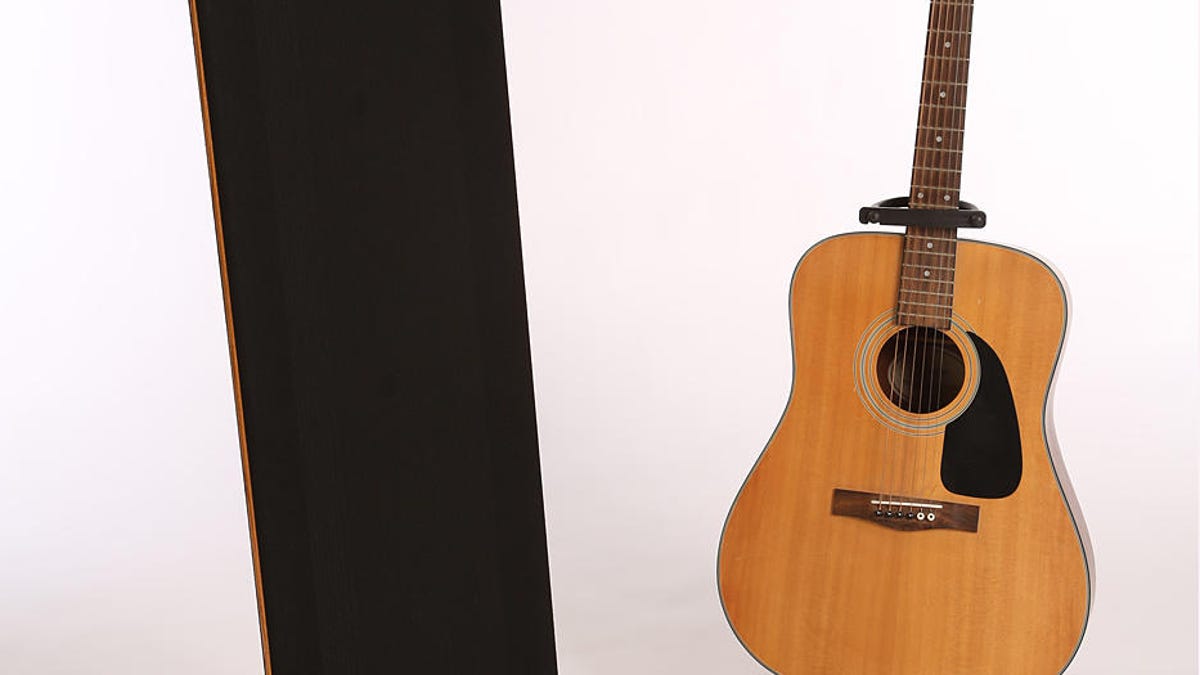Are you ready for bona-fide high-end speakers for $650 a pair?
Magnepan breaks the affordable sound quality barrier with its LRS speakers, which are hand-build in Minnesota.

The Magnepan LRS.
The Magnepan LRS -- it stands for little ribbon speaker -- isn't your typical high-end speaker, and not just because it's not expensive, at $650 a pair. The sound is remarkably clear, so music feels right.
Picture a "normal" speaker and what do you see? A box with a tweeter and a woofer. The box might be shiny black or maybe have a pretty wood veneer. The Magnepan LRS isn't a box, it's a slender, cloth-covered panel speaker, 1.25 inch thick. You don't have to be an audiophile to hear that it that doesn't sound like a box speaker -- it sounds bigger than that. Music sounds closer to life-size.
Magnepans also differ from conventional speakers in the way they project sound into a room: Box speakers radiate sound forward, whereas Magnepan panels radiate sound from their front and rear surfaces. Most speakers have dome tweeters and cone midrange and/or woofer drivers, but the LRS features a thin-film "ribbon" diaphragm that produces bass, midrange and treble frequencies.
The LRS is a big speaker, at 48 inches high and 14.5 inches wide. The panel comes in your choice of black solid oak or dark cherry edge trim, with off-white, gray or black fabric grilles. Impedance is rated at 4 ohms. Like more expensive Magnepans, the LRS is hand-crafted in White Bear Lake, Minnesota.
All good speakers should be placed with care to sound their best, but Magnepans are finickier than most. They only start to strut their stuff when placed a minimum of 3 feet (1 meter) from the wall behind them. That said, the LRSs are light enough to easily be moved into position for listening sessions, and pushed back up against the wall when the music's over.
The speakers were designed with audiophiles in mind -- people who are more likely to pair these speakers with high quality electronics, something better than an average AV receiver. The LRS works best with high power amps.
I say that because I experimented with a few amps with the LRS. The Dayton Audio DTA Pro sounded sweet and full, but lacking in detail. The NAD C 316BEE was too bright. At the other extreme was my Pass Labs XA25 amp, which unleashed the LRS' ultimate resolution potential. After jockeying those amps in and out of the system I spent the bulk of my LRS audition time with the $699 Schiit Vidar amp, which delivers 200 watts per channel into 4 ohm speakers (the LRS is a 4 ohm design).
Listening to the LRS
There's something especially satisfying about the way the LRS reproduced the sound of Pascal Rogé's piano on his Satie: 3 Gymnopoedies album. The instrument's transients and rich harmonics were rendered with incredible beauty. Rogé's phrasing and touch are extraordinary, and the LRS brought them to life.
The sound isn't warm or rich, so the LRS doesn't pretty up the sound of harsh or compressed pop recordings, but most of what's good shines through. The better the recording the better the LRS sounds, and you'll hear deep into the music. Turntablist Kid Koala's 12 Bit Blues album of palpable beats and textures exercised the LRS panels.
Its bass may not be the biggest and baddest, but its lowdown clarity was sublime with the timpani drums on my old Igor Stravinsky Conducts Histoire Du Soldat Suite LP. The tautness of the sound of tympani drums was preserved by the LRS.
I measured bass down to 50 Hz, so the LRS can sound full, but a subwoofer would be required for folks craving room-shakingly deep bass. Achieving a smooth bass blend between Magnepans and subs isn't easy, but I know lots of folks who get there. I mostly use Magnepans sans sub, but if the music calls for bass I'd recommend one of the smaller Hsu Research or REL models for use with the LRS.
Radiohead guitarist Jonny Greenwood's inspired and altogether unsettling score for Paul Thomas Anderson's film The Master was a treat for my ears. The orchestral sound blossomed over the LRS panels -- the strings were simply gorgeous. The panels may be thin, but the sound is anything but. With Steve Reich's Clapping Music, the fleshy quality of hand claps sounded just right. It's a great, hypnotic recording.
I didn't have the Klipsch RP 600M bookshelf speakers ($549 a pair) on hand for a direct comparison, but I know that speaker well enough to guess how it would go. The RP 600 is more dynamically alive, it's more rock and roll. The LRS is more refined, transparent, and it presents a bigger, closer to life-size sound. The RP 600M is a lot more sensitive, so it doesn't need a lot of power to fill a room.
The Magnepan LRS is the most transparent, high-definition sounding speaker you can buy for $650 a pair. It's amazing for the money, but Magnepan's .7 speaker offers a more natural midrange, superior dynamics and bass power for $1,395 per pair.
The LRS is available directly from Magnepan with a 60-day home trial. The speakers are also available from selected Magnepan dealers in the US and Canada.

